Author: Cristobal Carambo
School/Organization:
Philadelphia High School for Girls
Year: 2016
Seminar: Our Earth, A Fragile Home
Grade Level: 10
Keywords: Environmental Science, GEOLOGY OF PENNSYLVANIA, rock cycle, WISSAHICKON SCHIST, WISSAHICKON VALLEY
School Subject(s): Chemistry, Geology, Science
Connecting classroom science content to world outside the classroom is important as it makes the curriculum less abstract and more relevant in the student’s life. Such connections are especially critical in the environmental science class as so much of the content is focused on the ecology of the world outside of the classroom. This focus is at times problematic as many inner city students have had limited experiences with non-urban ecosystems. The chemistry of the Wissahickon Rocks Unit seeks to address these issues by investigating the geological history and chemistry of the rocks in the Wissahickon Valley Park. The Wissahickon Valley located in northeast Philadelphia is a nationally recognized “urban wilderness” where student can connect their classroom learning to a natural environment without leaving the city. This unit explores the valley’s ecology through an exploration of the geological history and chemistry of the rocks in the valley. The unit provides information on the geological history of the area, the chemistry of minerals, igneous and sedimentary rocks, as well as the metamorphic process that continually transform rocks. The unit will culminate in a series of trips to the Wissahickon wherein students can evaluate their understanding of the geology and chemistry of the Wissahickon Valley.
Download Unit: 16.03.01-unit.pdf
Did you try this unit in your classroom? Give us your feedback here.
Exploring the chemistry of the rock cycle will provide an opportunity to analyze how elements react to form minerals and how these minerals combine to form rocks. Analyzing the conditions that created the many types of igneous, sedimentary, and metamorphic rocks provides a forum in which to discuss how temperature, pressure, and time transform the chemical and physical properties of the minerals in rocks. Understanding the chemistry of metamorphic and sedimentary rocks will help us to more fully comprehend the nature of the ongoing changes in the geology of the earth. While many of the past geological transformations have been altered or obscured by periods of glaciation, the geological record of the Wissahickon is relatively well preserved, as it was not affected by the most recent ice age (West, 1993). As a result, millions of years of geological history are evident in the formations, outcroppings, folds and fractures that are readily observed throughout the valley. The valley and its waterway (the Wissahickon Creek) will provide the opportunity to study the interaction between chemistry, geology, ecology and the real world as we can learn how rocks form, how tectonic processes transform those rocks, and how present day activities threaten the sustainability of the many ecosystems found within the valley.
Students Will Be Able To:
Strategies: Students will review principles of chemical bonding by determining the formula for molecular & ionic compounds, and determining the ratio and charges of ions (mono and polyatomic) ionic compounds. Direct Instruction: Definition of elements, compounds, the octet rule, and bonding principles. Review of charges on anions, cations and charge neutrality in bonds. Minerals will be defined as naturally occurring solid compounds with definite chemical compositions. Classroom Activity: Students will use octet rule (and Lewis dot structures) to determine ratio of ions (and polyatomic ions) in ionic bonds. Students will then analyze the ratio of elements, mono-atomic and polyatomic ions in rock forming minerals. Students will also analyze the structure of end members in solid solutions of minerals Strategies: Students will diagram the bonding and shape of given minerals that form, islands, single / double chains, sheets, and three dimensional networks. Direct Instruction: Explanation of how bonds are formed between individual silicate tetrahedra to form the various structures. Cleavage is the tendency to break along planes of weakest bonding; thus silicate geometry can explain a mineral’s cleavage pattern. Classroom Activity: Students will diagram individual tetrahedra, determine how structural variations are made, then explain where / how cleavage will occur. Students will engage in the Architecture of Silicate Minerals Lab. Students will relate activity to geometry and cleavage patterns of specific minerals found in Wissahickon rocks. Strategies: Students will explore samples of igneous, sedimentary, and metamorphic rocks: they will note identifiable characteristics of each type of rock. They will then be given unknown samples and asked to identify them based on their observations. Direct Instruction: Description of the classes of rocks: igneous (intrusive, extrusive), sedimentary (clastic and chemical), and metamorphic rocks. Explanations of how differing rock types form; (how chemical / physical conditions affect their physical chemical properties) and how index minerals are used to determine the pressure, temperature, and depth of metamorphism. Classroom Activity: Comparing properties of rock samples, identifying different types of rock. Identifying unknown rock samples. Students will engage in a classification of rocks interactive video. Students will use the video overview to note general characteristics of the three types of rocks. Students will then analyze real samples of rocks and attempt to identify the rock type. What minerals are in these rocks Strategies: Students will view an interactive virtual tour of the Wissahickon rocks and attempt to identify the type of rock, its formation, and the minerals present in the rocks. Direct Instruction: Review of the physical properties of rock types, their physical / chemical properties, as well as the manner in which they formed (sedimentary / metamorphic). Review of the rock cycle and properties of rocks. Classroom Activity: Students will view the Virtual Tour of the Wissahickon which illustrates Wissahickon rocks. Students will note the physical features of each sample and determine the type of rock, how it was formed, the minerals present in the rock, the chemical structure, and physical properties (cleavage, hardness) of the rock. This day’s activity will serve as a formative assessment of learning to date. Strategies: Students will complete a historical time line activity, which relates biological and geological events to specific time periods. Students will also complete a lab that explores radiometric decay of carbon isotopes. Direct Instruction: The earth’s history is divided into eons, eras, periods, epochs, and ages. Each time period is characterized by type of living organisms and major geological events: (for this unit we will include the major landmasses and types of rocks formed) Fossils and rocks provide information used to establish the geological record and geography of landmasses. Radiometric dating uses the half-life decay rate of isotopes to determine the age of artifacts from the distant past. Isotopes are atoms of an element with the same atomic number but a different number of neutrons. Isotopes decay into other atoms at well-known rates. Scientists can use the half-life of isotopes to date rocks and fossils. Classroom Activity: Students will create a geological timeline that relates information living organisms and geologic events. Special attention will be given to the time of the Taconic, Arcadian, and Alleghenian Progenies, and the formation of the supercontinents of Rodinia, Euramerica, and Pangaea. Students will then engage in a lab activity that explores the concept of radiometric dating using the C14– N14 decay series (half-life = 5730 years). Once completed students will analyze the half-life data of other isotopes used to date older rock samples. Strategies: Students will use fossil / rock evidence to recreate Pangaea and then explain how mid ocean divergent plate boundaries affected the breakup of Pangaea. They will use coordinates of earthquakes / volcanoes to map the active regions of plate motion and explain why volcanoes / mountains, and earthquakes occur at plate boundaries. Direct Instruction: The lithosphere is divided into a series of tectonic plates (oceanic and continental crust). The interior of the earth is composed of three major sections: mantle, outer and inner core. Convection currents within the upper mantle (the asthenosphere) keep the plates in continual motion. The convergence of continental plates creates mountains, while the convergence of oceanic/ continental creates volcanoes. Divergent boundaries at mid ocean ridges cause seafloor spreading. Classroom Activity: Recreating Pangaea activity (with written explanation of rock and fossil evidence). Locating earth’s volcanoes and earthquakes activity: Summary paragraph explaining how plate motion creates new oceanic crust, mountains, and volcanoes. Strategies: Class will use timelines from earlier class, paying attention to the periods of mountain building, rifting, and processes of sedimentation, and rocks formed during each time period. Students will summarize information as constructed responses. Direct Instruction: Teacher will review The Geological History of the Wissahickon from late Proterozoic to now. Focus will be on periods of mountain building and rifting. Classroom Activity: Summarize geological history of Wissahickon as a constructed response.
Day One / Day Two Topic: Chemical Bonding
Essential Question
Objective: SWBAT: Analyze elements and ions in rock forming minerals
Standards: HS-PS1-1, Cssa-Ela. Rst11-12.9
Narrative: Part of this day’s lesson will be a review of the principals of bonding as most students have already had a year of chemistry. The focus of the review will be on the reasons why bonding occurs, the type of bonds formed, and the chemical composition of minerals. This will lead to a discussion of the chemical structure of rock forming minerals (silicates), solid solutions, and the molecular geometry of silicates.
Materials: Periodic tables, list of common rock forming minerals; list of solid solution end members.
Day Three / Four: Topic: Chemistry of Rock Forming Minerals
Essential Questions: How does the geometry of rock forming minerals affect their physical / chemical properties?
Objective: Describe geometry of rock forming minerals IOT analyze the relation between geometry and physical property
Standards: HS-PS1-1, & 2.2: Cssa-Ela. Rst11-12.8
Narrative: The lesson will explore the tetrahedral geometry of silicates and examine the variations that arise when silicate tetrahedra link together.
Materials: Illustrations of silicate structures, list of minerals in each structural class, illustration of bonding in silicate minerals, Architecture of Silicate Minerals lab handout. Lab located at: http://academic.brooklyn.cuny.edu/geology/powell/courses/geol7040/GEOL7040-Silicate%20Structures%20Activity.pdf
Day Five: Topic: Rock Cycle
Essential Questions: How are the three types of rocks related? Why is it referred to as the “Rock Cycle”?
Objective: To analyze the three rock types and explain how they interchange form.
Standards: HS-PS 2.2: Cssa-Ela. Rst11-12.9
Narrative: Today’s lesson will focus on how physical and chemical conditions affect the properties of rocks. The lesson begins with a general review of rocks and the rock cycle followed by a discussion of the minerals present in sedimentary and metamorphic rocks found in the Wissahickon. Students will use index minerals to analyze the conditions under which metamorphism occurred.
Materials: Rock samples kit, samples of each type of rock, computer cart for interactive video, rock properties handout, Graph of index minerals vs (heat, pressure and temperature). Lab located at: http://www.glencoe.com/sites/common_assets/science/virtual_labs/ES04/ES04.html and rock classification key handout.
Day Six Topic: Rocks and Minerals of the Wissahickon
Essential Questions: What are the main rock types in the Wissahickon?
Objective: To analyze the major classes of Wissahickon rocks, their minerals, and their physical properties.
Standards: HS-PS1-1, & 2.2: Cssa-Ela. Rst11-12.8
Narrative: Today students will use what they’ve learned to identify the major types of rocks in the Wissahickon. They will identify the minerals present and begin their explanation of how the rocks were formed. This is the first day of the Chemistry of Wissahickon rocks.
Materials: Virtual Tour of Wissahickon located @ http://www.personal.psu.edu/faculty/j/e/jea4/VWiss/Wisstopo.html
Day Seven / Day Eight: Topic: Geological History / Radiometric Dating
Essential Questions: What are the ages of man? How do we date fossils? How do we date rocks? How do we know how old the Earth is?
Objective: SWBAT Use half-life data of radioisotopes to explain methods of dating rocks and fossils.
Standards: HS-PS1-1, & 2.2: Cssa-Ela. Rst11-12.8
Narrative: The history of the Wissahickon rocks extends into the Paleozoic eon. In order to analyze the geological record, students need to have a firm grasp of Geological Time Periods and the manner in which we date material from the past.
Materials: Large diagram of geological time periods, individual handouts with data for each time period, and construction paper: Radiometric dating lab handout, lab materials (100 pennies, boxes, graph paper); lab available @ http://kenstonlocal.org/wilk/wp-content/uploads/2016/01/Radiometric-Dating-Activity.pdf
Day Nine / Day Ten: Topic: Plate Tectonics
Essential Questions:
Objective: SWBAT Use theory of plate tectonics to explain the formation and rifting of the supercontinents throughout time.
Standards: HS-PS1-1, & 2.2: Cssa-Ela. Rst11-12.8
Narrative: Plate tectonic theory provides an explanation for the motion of continents, ocean basins, sea floor spreading, earthquakes as well as the creation of mountains / volcanoes, and supercontinents. Evidence from the fossil and rock record supports the existence of super continents such as Rodinia, Gondwana, and Pangaea. The formation of important mountain ranges in North America coincided with the creation of these supercontinents, which are central to the geological history of Wissahickon rocks.
Materials: Pangaea activity handout, paper, scissors, etc., fossil / rock record data: coordinates of volcanoes / earthquakes, map projections (Mercator), a Globe.
Day Eleven: Wissahickon Geological History
Essential Questions: What are the processes / events that formed the Wissahickon Valley?
Objective: SWBAT: Summarize the geological history of Wissahickon Formation and the rocks found in the Wissahickon Valley.
Standards: HS-PS1-1, & 2.2: Cssa-Ela. Rst11-12.8
Narrative: This class combines the chemistry of Wissahickon rocks and the geologic record of the area. We will review our time lines and write a summary of the geological history of the rocks.
Materials: Geological Time lines.
Alcock, J. (2012). Retrieved 2016, from Virtual Geologic Tour of Wissahickon Creek, Philadelphia, Pennsylvania: www.personal.psu.edu/faculty/j/e/jea4/VWiss/Wisstopo.html Barnes, J. H., & Sevon, W. D. (2016). The geological story of Pennsylvania (4th ed.) (Vol. 4th series ). (E. S. 4, Ed.) Harrisburg: Pennsylvania Geological Survey . Crawford, M. L. (1987). The Wissahickon schist type section: Wissahickon Creek, Philadelphia Pennsylvania; Crawford, Mary Luisa;. In G. S. America, Northeastern Section of the Geological Society of America: Centennial Field guide number five (pp. 77-80). Boulder , Co: Geological Society of America . Department of Geology at the University of Minnesota. (2009, January 9). College of Science and Engineering. Retrieved June 14, 2016, from ESCI 1001 Mineral Web Pages : https://www.esci.umn.edu/courses/1001/minerals Fichter, L. S. (2000, October 25). Metamorphic Rocks. Retrieved May 22, 2016, from Barrovian Metamorphism and Metamorphic Grade: http://csmres.jmu.edu/geollab/Fichter/MetaRx/Barrovian.html Friend of the Wissahickon. (2016, January 5). Plan Your Visit. Retrieved May 22, 2016, from Friends of the Wissahickon: http://www.fow.org/visit-the-park/ Gasiorowski, C. (1997). Philadelphia’s Wissahickon Valley: Its geology and geography. Middle States Geographer (30), 42-49. Mitchell, J. K., & Kenich, S. (2005). Fundamentals of Soil Behavior. Hoboken, New Jersey: John Wiley & Sons . Munsee Delaware Indian Nation-USA. (2014, January 25). Lenape History . Retrieved May 28, 2016, from Munsee Delaware Indian Nations -USA: http://www.munseedelawareindiannation-usa.us/page07.html Nelson, S. (2013, Sept. 30). Mineral Chemistry. Retrieved May 22, 2016, from Earth and Environmental Sciences 2110: http://www.tulane.edu/~sanelson/eens211/mineral_chemistry.htm Rakovan, J. (2005). Solid Solution . Rocks and minerals , 80, 449-450. Tarbuck, E. J. (2006). Earth Science . Upper Saddle River , NJ: Pearson Prentiss Hall. West. (1993). Rediscovering the Wissahickon Through its science and history. Philadelphia: Westford Press. West. (1998, January 8). Gems of the Wissahickon. Retrieved April 28, 2016, from http://www.rtsd.org/cms/lib9/PA01000218/Centricity/Domain/418/Gems%20of%20the%20Wissahickon.pdf
Figures and Tables Source http://cdn.phillymag.com/wp-content/uploads/2014/08/00000.jpg Figure 2: Rodinia: Proterozoic Eon Figure 3: The Iapetus Ocean: Cambrian Period Figure 4: Euramerica Forms: Plate tectonic maps and Continental drift animations by C. R. Scots, PALEOMAP Project (www.scotese.com) Figure 5: Pangaea Forms Plate tectonic maps and Continental drift animations by C. R. Scotese, PALEOMAP Project (www.scotese.com) Figure 6: Wissahickon Schist Table 1: Barrovian Metamorphism Figure 9: Phylosilicate Ring Structure Source: (Nelson, 2013) Figure 8 Silicate Structures Source: (Tarbuck, 2006) Figure 10: T-O & T-O-T Layers in Silicate Bonding Source: http://images.slideplayer.com/25/7963085/slides/slide_13.jpg Figure 11: Bonding in Muscovite Source: Crystal Structure Gallery, National Institute of Advanced Industrial Science and Technology (AIST) https://staff.aist.go.jp/nomura-k/english/itscgallary-e.htm Geological Time Line Source: (Barnes & Sevon, 2016) Mohs Hardness Scale Source: http://diamondabrasives.eu/wp-content/uploads/2013/12/MohsHardnessScale-from-igs.indiana.edu_.jpg
Figure 1 Wissahickon Schist in Philadelphia Architecture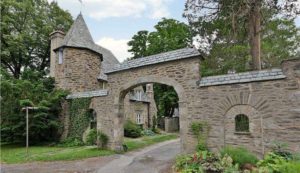
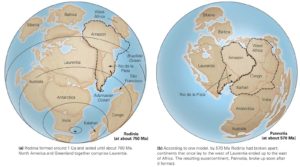
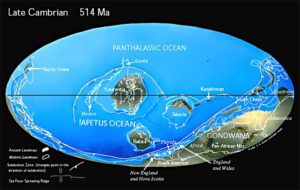
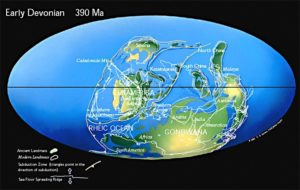
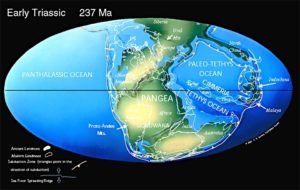

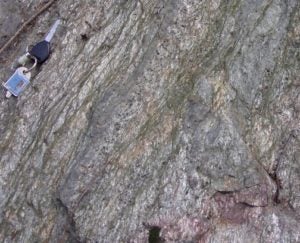
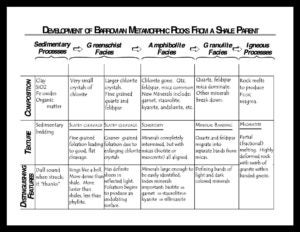

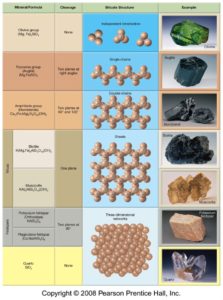

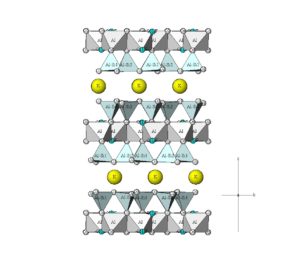
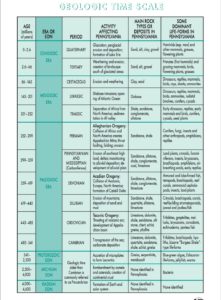
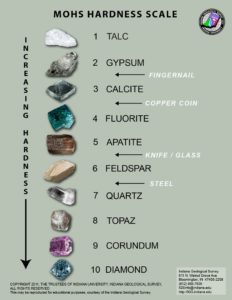
Common Core literacy standards:
Next Generation Science Standards